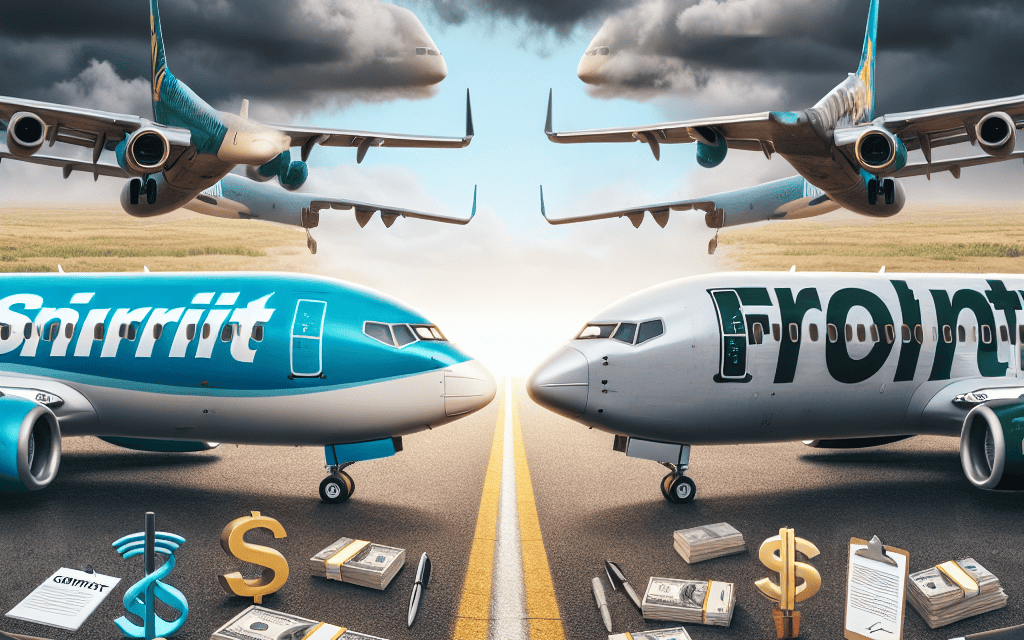“Spirit and Frontier Resume Merger Talks: Navigating Turbulence Ahead”
Introduction
In early 2022, Spirit Airlines and Frontier Airlines resumed discussions regarding a potential merger, aiming to create a formidable low-cost carrier in the U.S. aviation market. This merger, if successful, would combine Spirit’s extensive network in the eastern United States with Frontier’s strong presence in the west, potentially offering consumers more competitive fares and expanded route options. However, the merger faces significant hurdles, including regulatory scrutiny over antitrust concerns and the challenge of integrating two distinct corporate cultures and operational systems. Additionally, both airlines must navigate the complexities of aligning their business strategies and addressing concerns from stakeholders and employees. As the talks progress, the outcome remains uncertain, with both potential benefits and obstacles shaping the future of this proposed union.
Overview Of Spirit And Frontier’s Merger Talks
Spirit Airlines and Frontier Airlines have resumed discussions regarding a potential merger, a move that could significantly reshape the landscape of the low-cost airline industry in the United States. This development comes after previous negotiations between the two carriers were halted, primarily due to regulatory concerns and competitive pressures. As these talks recommence, both airlines are keenly aware of the potential benefits and challenges that such a merger could entail.
The rationale behind the merger is clear: by combining forces, Spirit and Frontier aim to create a more formidable competitor to the major U.S. airlines, such as American, Delta, and United. Both Spirit and Frontier have built their reputations on offering low-cost travel options, and a merger could enhance their ability to provide even more competitive pricing and expanded route networks. This could potentially lead to increased market share and improved financial performance for the combined entity. Moreover, the merger could allow for greater operational efficiencies, as the airlines could streamline their fleets, consolidate routes, and reduce overhead costs.
However, despite these potential advantages, several obstacles loom on the horizon. One of the primary concerns is regulatory approval. The U.S. Department of Justice and other regulatory bodies are likely to scrutinize the merger closely, given the potential impact on competition within the airline industry. Regulators will be particularly interested in ensuring that the merger does not lead to higher prices for consumers or reduced service quality. To address these concerns, Spirit and Frontier may need to make concessions, such as divesting certain routes or assets, to gain regulatory approval.
In addition to regulatory hurdles, the airlines must also consider the integration challenges that often accompany mergers. Combining two distinct corporate cultures, operational systems, and workforces can be a complex and time-consuming process. Successful integration will require careful planning and execution to ensure that the merger achieves its intended benefits without disrupting service or alienating employees and customers. Furthermore, both airlines will need to communicate effectively with their stakeholders to maintain confidence and support throughout the merger process.
Another potential obstacle is the competitive response from other airlines. Major carriers are unlikely to sit idly by as Spirit and Frontier attempt to strengthen their position in the market. These competitors may respond with aggressive pricing strategies, enhanced loyalty programs, or expanded service offerings to retain their customer base and counter the threat posed by a merged Spirit-Frontier entity. As a result, Spirit and Frontier will need to be prepared to navigate an increasingly competitive environment as they pursue their merger ambitions.
Despite these challenges, the resumption of merger talks between Spirit and Frontier signals a renewed commitment to exploring the potential synergies and benefits that a combined airline could offer. Both carriers recognize the importance of adapting to the evolving dynamics of the airline industry and are seeking ways to enhance their competitive standing. As discussions progress, stakeholders will be watching closely to see how Spirit and Frontier address the various obstacles they face and whether they can ultimately achieve a successful merger that delivers value to customers, employees, and shareholders alike.
Potential Benefits Of The Spirit-Frontier Merger
The resumption of merger talks between Spirit Airlines and Frontier Airlines has reignited discussions about the potential benefits such a union could bring to the aviation industry. As two of the most prominent low-cost carriers in the United States, Spirit and Frontier have long been seen as natural partners, with complementary strengths that could create a formidable competitor in the market. However, while the potential advantages of this merger are significant, it is essential to consider the challenges that may arise in the process.
One of the primary benefits of a Spirit-Frontier merger is the potential for increased operational efficiency. By combining their resources, the two airlines could streamline their operations, reduce redundancies, and achieve economies of scale. This could lead to lower operating costs, which in turn might allow the merged entity to offer even more competitive fares to consumers. In an industry where price sensitivity is a critical factor for many travelers, the ability to provide lower fares could significantly enhance the merged airline’s market position.
Moreover, the merger could result in an expanded route network, offering passengers more choices and greater convenience. Spirit and Frontier currently serve different, albeit overlapping, markets. By merging, they could optimize their route offerings, reduce overlap, and introduce new destinations that were previously unfeasible for either airline independently. This expanded network could attract a broader customer base, including both leisure and business travelers, thereby increasing market share.
In addition to operational efficiencies and an expanded route network, the merger could also lead to enhanced customer service. By pooling their resources, Spirit and Frontier could invest in technology and infrastructure improvements that enhance the overall passenger experience. This might include upgrades to booking systems, more efficient check-in processes, and improved in-flight amenities. Such enhancements could help the merged airline differentiate itself from other low-cost carriers and attract a more loyal customer base.
However, while the potential benefits are compelling, several obstacles could impede the successful execution of this merger. Regulatory scrutiny is one such challenge. The aviation industry is heavily regulated, and any merger of this magnitude would likely attract the attention of antitrust authorities. Regulators would closely examine the potential impact on competition, particularly in markets where Spirit and Frontier have significant overlap. Ensuring that the merger does not lead to reduced competition or higher fares for consumers will be a critical hurdle to overcome.
Furthermore, integrating the operations and cultures of two distinct airlines is no small feat. Spirit and Frontier have different corporate cultures, operational practices, and brand identities. Successfully merging these elements will require careful planning and execution to avoid disruptions that could negatively impact employees and customers alike. Effective communication and change management strategies will be essential to ensure a smooth transition.
In conclusion, while the potential benefits of a Spirit-Frontier merger are substantial, including increased operational efficiency, an expanded route network, and enhanced customer service, significant challenges remain. Regulatory scrutiny and the complexities of integration are formidable obstacles that must be addressed to realize the full potential of this union. As the talks progress, stakeholders will be keenly watching to see how these issues are navigated and whether the merger can ultimately deliver on its promise to reshape the landscape of low-cost air travel in the United States.
Regulatory Challenges Facing The Spirit-Frontier Merger
Spirit Airlines and Frontier Airlines have resumed merger discussions, a move that has captured the attention of industry analysts and regulatory bodies alike. This potential merger, if successful, would create a formidable low-cost carrier in the United States, potentially reshaping the competitive landscape of the airline industry. However, as these talks progress, significant regulatory challenges loom on the horizon, posing potential obstacles to the merger’s completion.
To begin with, the merger would likely face intense scrutiny from the U.S. Department of Justice (DOJ) and the Federal Trade Commission (FTC), both of which are tasked with ensuring that such consolidations do not harm consumer interests or stifle competition. The primary concern for regulators would be whether the merger would lead to reduced competition in the airline industry, which could result in higher fares, fewer choices, and diminished service quality for consumers. Given that Spirit and Frontier are two of the largest ultra-low-cost carriers in the country, their merger could potentially reduce the competitive pressure on larger airlines to keep prices low, thereby affecting the overall market dynamics.
Moreover, the merger would also need to address concerns related to market concentration. The combined entity would hold a significant share of the market, particularly in certain regions where both airlines currently operate. This could lead to a monopolistic or oligopolistic scenario, where the lack of competition might allow the merged airline to exert undue influence over pricing and service offerings. Regulators would likely require a thorough analysis of market concentration in key regions to ensure that the merger does not create anti-competitive conditions.
In addition to market concentration, the merger talks must also consider the potential impact on labor and employment. Both Spirit and Frontier employ thousands of workers, and a merger could lead to job redundancies and restructuring. Labor unions and employee groups are likely to voice concerns about job security and working conditions, which could add another layer of complexity to the regulatory review process. Regulators may require assurances that the merger will not result in significant job losses or deteriorating labor conditions.
Furthermore, the merger would need to navigate the complexities of integrating two distinct corporate cultures and operational systems. While this is primarily an internal challenge, it could have regulatory implications if the integration process affects service quality or operational efficiency. Regulators may seek guarantees that the merger will not disrupt service or lead to operational inefficiencies that could negatively impact consumers.
In light of these challenges, Spirit and Frontier will need to present a compelling case to regulators, demonstrating that the merger will ultimately benefit consumers by creating a stronger, more competitive airline. This could involve commitments to maintaining low fares, expanding route networks, and investing in service improvements. Additionally, the airlines may need to propose divestitures or other remedies to address specific regulatory concerns, such as selling off certain routes or assets to maintain competitive balance in the market.
In conclusion, while the resumption of merger talks between Spirit and Frontier presents an opportunity to create a powerful low-cost carrier, the path forward is fraught with regulatory challenges. The airlines will need to carefully navigate these obstacles, addressing concerns related to competition, market concentration, labor, and operational integration. Only by satisfying regulatory requirements and demonstrating clear consumer benefits can the merger hope to gain approval and reshape the airline industry landscape.
Impact On Consumers If Spirit And Frontier Merge

The resumption of merger talks between Spirit Airlines and Frontier Airlines has reignited discussions about the potential impact on consumers. As two of the most prominent low-cost carriers in the United States, a merger between Spirit and Frontier could significantly reshape the landscape of budget air travel. However, while the prospect of a combined entity promises certain benefits, it also raises concerns about potential drawbacks for consumers.
To begin with, a merger could lead to enhanced operational efficiencies. By combining their resources, Spirit and Frontier might streamline their operations, potentially resulting in cost savings. These savings could be passed on to consumers in the form of lower fares, which is a primary attraction of low-cost carriers. Additionally, a merger could expand the route network of the combined airline, offering passengers more destinations and increased flight frequency. This could be particularly beneficial for travelers in underserved markets, where the presence of a larger low-cost carrier might introduce more competitive pricing and service options.
Moreover, the merger could lead to improved service offerings. With a larger fleet and more extensive resources, the combined airline might be able to invest in better customer service, enhanced in-flight amenities, and more reliable scheduling. This could address some of the criticisms that both Spirit and Frontier have faced regarding customer satisfaction. Furthermore, a merger could provide the financial stability needed to weather economic downturns, ensuring that consumers continue to have access to affordable travel options even during challenging times.
However, despite these potential benefits, there are significant concerns that must be addressed. One major issue is the potential reduction in competition. Currently, Spirit and Frontier compete directly on many routes, which helps keep prices low. A merger could reduce this competition, potentially leading to higher fares. This is particularly concerning in markets where the combined airline would hold a dominant position, as reduced competition could diminish the incentive to maintain low prices and high service standards.
Additionally, there is the risk of reduced consumer choice. While a merger might expand the route network, it could also lead to the elimination of overlapping routes and services. This could result in fewer options for travelers, particularly those who rely on specific routes that might be deemed redundant by the merged entity. Furthermore, the integration process itself could lead to disruptions in service, as the two airlines work to align their operations, systems, and cultures. Such disruptions could negatively impact the travel experience for consumers in the short term.
Regulatory scrutiny is another potential obstacle. Antitrust authorities will closely examine the merger to ensure it does not harm competition or consumer interests. The airlines will need to demonstrate that the merger will not lead to monopolistic practices or unfair pricing. This scrutiny could result in conditions being imposed on the merger, such as the divestiture of certain routes or assets, which could influence the ultimate impact on consumers.
In conclusion, while the merger talks between Spirit and Frontier present opportunities for enhanced service and expanded options for consumers, they also pose significant challenges. The potential reduction in competition and consumer choice, along with regulatory hurdles, must be carefully considered. As the discussions progress, it will be crucial for stakeholders to balance the potential benefits with the need to protect consumer interests, ensuring that the merger, if it proceeds, ultimately serves to enhance the landscape of budget air travel.
Competitive Landscape Changes Post-Merger
Spirit Airlines and Frontier Airlines have resumed merger discussions, a move that could significantly alter the competitive landscape of the U.S. airline industry. This potential merger, if successful, would create a formidable low-cost carrier, poised to challenge the dominance of larger airlines. However, while the merger promises to reshape the market dynamics, several potential obstacles could impede its progress.
The resumption of talks between Spirit and Frontier comes at a time when the airline industry is gradually recovering from the disruptions caused by the COVID-19 pandemic. As travel demand rebounds, airlines are seeking ways to optimize operations and expand their market share. A merger between Spirit and Frontier would not only consolidate their resources but also enhance their ability to compete with major carriers such as American Airlines, Delta Air Lines, and United Airlines. By combining their fleets, routes, and customer bases, the merged entity could offer more competitive pricing and expanded service options, appealing to cost-conscious travelers.
However, the path to a successful merger is fraught with challenges. One of the primary concerns is regulatory scrutiny. The U.S. Department of Justice (DOJ) and other regulatory bodies are likely to closely examine the merger to ensure it does not violate antitrust laws. Regulators will assess whether the merger would lead to reduced competition, higher fares, or diminished service quality. Given the current administration’s focus on promoting competition and consumer protection, obtaining regulatory approval could prove to be a significant hurdle.
In addition to regulatory challenges, the merger faces potential opposition from labor unions and employees. Integrating the workforces of two airlines with distinct corporate cultures and labor agreements can be a complex and contentious process. Ensuring a smooth transition for employees while maintaining operational efficiency will require careful negotiation and planning. Labor unions may demand assurances regarding job security, wages, and working conditions, adding another layer of complexity to the merger process.
Moreover, the integration of technology and operations presents another potential obstacle. Merging two airlines involves aligning their IT systems, booking platforms, and operational procedures. This integration must be seamless to avoid disruptions that could negatively impact customer experience and brand reputation. Any missteps in this area could lead to operational inefficiencies and customer dissatisfaction, undermining the benefits of the merger.
Despite these challenges, the potential benefits of a Spirit-Frontier merger are substantial. By combining their strengths, the airlines could achieve economies of scale, reduce operational costs, and enhance their competitive positioning. The merged entity would have a broader network, offering more destinations and flight options to passengers. This expanded reach could attract a larger customer base, increasing revenue and market share.
Furthermore, the merger could stimulate competition in the low-cost segment of the airline industry. With a stronger presence, the combined airline could exert pressure on other carriers to lower fares and improve service offerings. This increased competition could ultimately benefit consumers, providing them with more choices and better value for their money.
In conclusion, while the resumption of merger talks between Spirit and Frontier holds the promise of reshaping the competitive landscape of the airline industry, several potential obstacles loom on the horizon. Regulatory scrutiny, labor integration, and operational challenges must be carefully navigated to ensure a successful merger. If these hurdles can be overcome, the merger could create a powerful low-cost carrier capable of challenging the industry’s major players and delivering enhanced value to consumers.
Financial Implications For Spirit And Frontier
Spirit Airlines and Frontier Airlines have resumed merger discussions, a move that could significantly reshape the landscape of the low-cost airline industry in the United States. This potential merger, if successful, would create a formidable competitor in the budget travel sector, offering a broader network and potentially more competitive pricing for consumers. However, while the merger presents numerous opportunities, it also brings with it a host of financial implications and potential obstacles that both companies must carefully navigate.
To begin with, the merger could lead to substantial cost synergies for both Spirit and Frontier. By combining their operations, the airlines could achieve economies of scale, reducing operational costs through shared resources, streamlined processes, and enhanced bargaining power with suppliers. This could result in lower costs per available seat mile, a critical metric in the airline industry, thereby improving profitability. Additionally, the merger could enable the combined entity to optimize its route network, eliminating redundancies and focusing on the most profitable routes. This strategic realignment could enhance revenue generation and improve overall financial performance.
However, the financial benefits of the merger are not without potential challenges. One significant concern is the integration of the two companies’ operations, which can be a complex and costly endeavor. Merging different corporate cultures, aligning IT systems, and harmonizing labor contracts are just a few of the hurdles that must be overcome. These integration efforts require substantial investment and careful management to avoid disruptions that could negatively impact customer service and brand reputation. Moreover, the initial costs associated with the merger, such as legal fees, advisory costs, and potential severance packages, could strain the financial resources of both airlines in the short term.
Furthermore, regulatory scrutiny poses another potential obstacle to the merger. The airline industry is heavily regulated, and any consolidation is likely to attract the attention of antitrust authorities. Regulators will closely examine the merger to ensure it does not lead to reduced competition, higher fares, or diminished service quality for consumers. Spirit and Frontier will need to present a compelling case that the merger will benefit consumers and the industry as a whole, which may involve making concessions or divesting certain assets to gain regulatory approval.
In addition to regulatory challenges, the merger could face opposition from labor unions representing the airlines’ employees. Unions may be concerned about potential job losses or changes to working conditions resulting from the merger. Addressing these concerns will be crucial to maintaining workforce morale and ensuring a smooth transition. Both airlines will need to engage in transparent and constructive dialogue with their employees and union representatives to mitigate any potential labor disputes.
In conclusion, while the resumption of merger talks between Spirit and Frontier presents a promising opportunity to create a stronger, more competitive low-cost airline, it also brings with it a range of financial implications and potential obstacles. Achieving the anticipated cost synergies and revenue enhancements will require careful planning and execution. Moreover, navigating regulatory scrutiny and addressing labor concerns will be critical to the success of the merger. As the discussions progress, stakeholders will be closely watching to see how Spirit and Frontier address these challenges and capitalize on the potential benefits of their union.
Historical Context Of Airline Mergers In The U.S
The history of airline mergers in the United States is a complex tapestry woven with strategic decisions, regulatory challenges, and market dynamics. As Spirit and Frontier resume merger talks, it is essential to understand the historical context that has shaped the landscape of airline consolidations in the country. Over the past few decades, the U.S. airline industry has witnessed a series of significant mergers that have redefined the competitive environment and altered the trajectory of air travel.
In the late 20th century, the airline industry began to see a wave of consolidations, driven by the need to achieve economies of scale, expand route networks, and enhance operational efficiencies. The Airline Deregulation Act of 1978 played a pivotal role in setting the stage for these mergers by removing government control over fares, routes, and market entry. This deregulation led to increased competition, prompting airlines to seek mergers as a strategy to survive and thrive in a rapidly changing market.
One of the most notable mergers in recent history was the 2008 combination of Delta Air Lines and Northwest Airlines. This merger created one of the world’s largest airlines and set a precedent for subsequent consolidations. The Delta-Northwest merger demonstrated how airlines could leverage synergies to improve their financial performance and expand their global reach. Similarly, the 2010 merger between United Airlines and Continental Airlines further underscored the trend of consolidation, resulting in a more robust network and enhanced customer offerings.
As Spirit and Frontier engage in merger discussions, they are undoubtedly aware of the lessons learned from past consolidations. However, potential obstacles loom on the horizon, reminiscent of challenges faced by their predecessors. Regulatory scrutiny remains a significant hurdle, as antitrust authorities closely examine the potential impact on competition and consumer choice. The Department of Justice (DOJ) has historically played a crucial role in evaluating airline mergers, ensuring that they do not lead to monopolistic practices or harm consumer interests.
Moreover, integrating operations, cultures, and systems poses another formidable challenge. The merger of American Airlines and US Airways in 2013 highlighted the complexities involved in harmonizing different corporate cultures and operational frameworks. Successful integration requires meticulous planning and execution to avoid disruptions that could affect service quality and customer satisfaction.
In addition to regulatory and integration challenges, Spirit and Frontier must also consider the evolving dynamics of the airline industry. The COVID-19 pandemic has reshaped air travel, with fluctuating demand patterns and changing consumer preferences. As the industry recovers, airlines are reevaluating their strategies to adapt to the new normal. A merger between Spirit and Frontier could potentially create a more competitive low-cost carrier, capable of capturing a larger share of the market by offering affordable fares and expanded route options.
In conclusion, the resumption of merger talks between Spirit and Frontier is set against a backdrop of historical airline consolidations that have transformed the U.S. aviation landscape. While the potential benefits of such a merger are evident, the path forward is fraught with challenges that require careful navigation. By drawing on the experiences of past mergers and addressing potential obstacles head-on, Spirit and Frontier have the opportunity to shape the future of air travel in a way that benefits both the companies and their customers.
Q&A
1. **What are Spirit and Frontier?**
Spirit Airlines and Frontier Airlines are both ultra-low-cost carriers in the United States.
2. **What is the purpose of their merger talks?**
The merger aims to create a larger ultra-low-cost carrier to better compete with major airlines by expanding their network and reducing operational costs.
3. **What are the potential benefits of the merger?**
The merger could lead to increased market share, cost synergies, expanded route networks, and enhanced competitive positioning against larger airlines.
4. **What obstacles could the merger face?**
Potential obstacles include regulatory scrutiny from antitrust authorities, integration challenges, and opposition from labor unions or consumer advocacy groups.
5. **Why might regulators scrutinize the merger?**
Regulators may be concerned about reduced competition, potential fare increases, and the impact on consumer choice in the airline industry.
6. **How could labor unions impact the merger?**
Labor unions might oppose the merger if they believe it could lead to job losses, changes in working conditions, or unfavorable contract terms for employees.
7. **What is the current status of the merger talks?**
As of the latest reports, Spirit and Frontier have resumed discussions, but no final agreement has been reached, and significant hurdles remain.
Conclusion
Spirit Airlines and Frontier Airlines have resumed merger discussions, aiming to create a more competitive low-cost carrier in the U.S. aviation market. However, potential obstacles could hinder the merger’s success. Regulatory scrutiny is a significant concern, as antitrust authorities may closely examine the deal’s impact on competition and consumer choice. Additionally, integrating operations, aligning corporate cultures, and addressing labor union concerns present challenges. The merger’s success will depend on effectively navigating these hurdles while demonstrating clear benefits to stakeholders, including passengers, employees, and shareholders.





